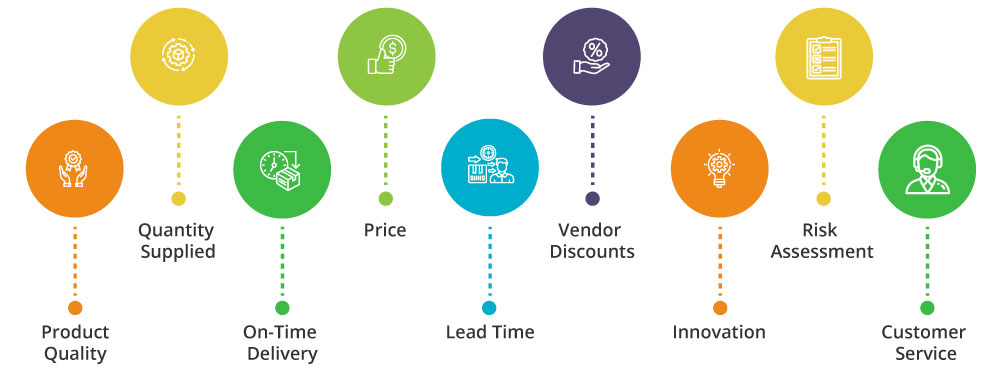What is Vendor Performance Management?
Every manufacturing and distribution company deals with multiple vendors. Managing vendors is crucial for every company to improve efficiency and meet customer demands. Vendor performance management, also known as supplier performance management (SPM), involves monitoring, analyzing, and evaluating all vendors based on predetermined key performance indicators (KPIs). To conduct vendor rating and assess vendors, criteria are not limited to quantitative measures; they can also include evaluating a vendor’s performance based on qualitative measures.
Companies experience a gap between monitoring how the vendors perform and how each vendor affects the business operations. With the right system and technology, vendor performance management helps bridge this gap between buyer and vendor to carry out business operations smoothly.
Vendor Management KPIs For Evaluation
For successful vendor evaluation process, you need to establish vendor management key performance indicators (KPIs) or criteria to measure their performance and rate them based on predetermined criteria. Unique KPIs can be set depending on your organization’s needs and requirements.
Based on these parameters, we have listed some essential KPIs and vendor performance metrics manufacturers and distributors need to track and maintain vendor performance scorecard.

Product Quality
Test the quality of the product received from each vendor by performing quality control tests to check if the product supplied by the vendor meets the specifications. Evaluate and track vendors based on the quality of the products they supply. You might purchase the same stock item from multiple vendors. With vendor management software, you can rate and evaluate vendors based on product quality and track defects or quality failures in the product.
Quantity Supplied
Monitor whether the vendors supply the precise quantities raised in the purchase order. If this is not tracked correctly, it may affect inventory levels and drive up costs. Rate the vendors based on their supply quantities to determine whether they can meet the demands and order quantity against the total order.
On-Time Delivery
On-time delivery refers to the time that vendors take to deliver the products. Track the vendors based on their willingness to meet the timeliness of your purchase order. If the vendors delay the orders and don’t meet the delivery date of the purchase order, it may lead to production delays and shipment delays to meet customer demands and affect the costs involved.
Price
Price can be very sensitive for many manufacturers and distributors, directly affecting the costs involved in production. You can track vendors based on price volatility and variances. Evaluate vendors based on the price they offer to meet profits and ensure cost savings.
Lead Time
Monitor your supplier’s lead time performance regularly. Lead time data can be tracked and analyzed using various tools and methods, such as dashboards, reports, charts, or software. Compare the actual lead time with the standard lead time and identify the causes of deviations to assess their impact on your operations and customer satisfaction.
Vendor Discounts
Tracking discounts will allow you to gain valuable insights into cost-effectiveness. By monitoring discounts, businesses can identify vendors providing products at the most competitive prices, enabling informed purchasing decisions and potential cost savings.
Innovation
This relates to how the vendors innovate in the product/service they offer compared to other vendors who do not focus on innovation and upgrading the product. Analyze the additional value offered with the product/service.
Risk Assessment
Assess the risk associated with the vendors. Evaluate each vendor’s credibility regarding financial stability, adherence to quality control standards and compliance, licenses, and certification requirements.
Customer Service
Track and analyze vendors responsiveness and how quickly they handle any complaints or issues with the products or services that arise. You need to make sure they are helpful in providing quick assistance if needed.
How To Track Vendor Performance?
Organizations need to adopt a systematic approach when tracking vendor performance, which involves establishing clear performance metrics, conducting regular evaluations through scorecards, and fostering open communication. These are some ways to effectively track the vendor performance based on KPIs that you have set for your organization.
Manage Scorecards
Analyze vendor performance by setting KPIs with the weightage they hold to measure it. Assign appropriate weightage to each KPI according to organizational requirements. Scorecards will give you better visibility when you evaluate vendors. This will help you make better decisions by closely knowing each vendor’s score based on the set criteria and KPIs.
Centralize Data
Maintain certificates required to meet industry, regulatory, and compliance requirements to know if your vendors meet the compliance requirements. Centralize data and vendor records to easily access information such as certification validity, license number, and authorized registration number.
Integrate Technology
Integrate technology with a proper vendor performance rating system to streamline the vendor review process with automation. Instead of manually managing reviews in the spreadsheet, which may lead to errors, implement a system to track and evaluate the vendors with your KPIs regularly. Organizations can ensure transparency, accountability, and continuous improvement in vendor relationships by implementing robust tracking mechanisms and leveraging technology solutions.
Benefits of Vendor Performance Evaluation
To ensure smoother operations in your company, you need to monitor and rate vendors based on the established KPIs. Tracking and rating your vendor’s performance with accurate metrics has benefits.
Enhanced Visibility
Gain enhanced visibility into vendor’s performance across various metrics with vendor performance evaluation, enabling organizations to make data-driven decision-making. Identify areas of their strength and weakness. Ensure the vendor aligns with your expectations and that you can address the issues proactively, if any.
Operational Efficiency
Assessing vendor performance allows organizations to streamline processes, optimize resource allocation, reduce waste, and identify pinpoints throughout their supply chain. This evaluation allows the identification of bottlenecks, redundancies, and areas of improvement, enabling preemptive measures to enhance operational efficacy.
Vendor Collaboration
Effective vendor performance evaluation fosters better collaboration between organizations and vendors. Established key performance indicators and metrics help align the vendor’s goals with your organization’s goals. Regular vendor performance ratings and feedback facilitate vendor performance improvement to meet the organization’s expectations. This collaborative approach fosters improvement and better vendor collaboration.
Cost Saving
Assessing vendors based on essential parameters for your organization can lead to cost savings and reduce waste. By identifying underperforming vendors or areas of inefficiency, you can optimize resources and costs. Consider renegotiating terms or seeking alternative vendors to maximize value and minimize expenses across the supply chain.
Conclusion
Vendor performance management is critical to ensuring smooth operations and maintaining high standards in manufacturing and distribution companies. By implementing robust vendor management KPIs, organizations can effectively evaluate their key vendors and facilitate ongoing enhancement across diverse facets of vendor performance.
Integrate eWorkplace Apps Quality Management Suite for Acumatica that facilitates a comprehensive vendor performance rating system. This helps to track and evaluate vendor performance across various metrics, enabling organizations to make data-driven decisions and improve operational efficiency while ensuring that the products meet quality standards.
Contact Us
"*" indicates required fields













